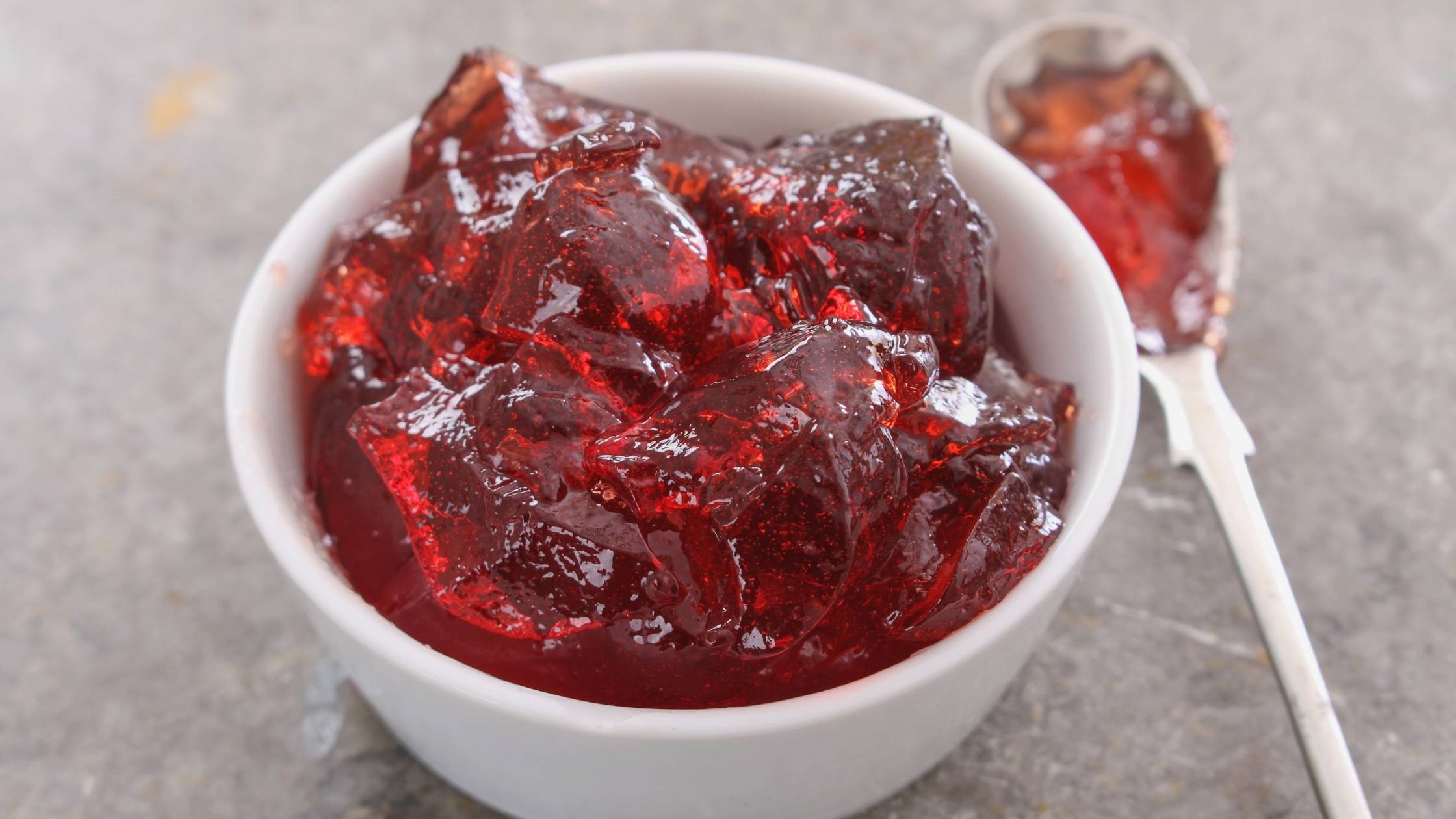Last Updated on 05/18/2021 by Veronica Jones
In a word, no. Although there are some minor exceptions, it’s pretty much something you shouldn’t feed your dog, however much they beg!
For the vast majority of pet owners, dogs are part of the family and, as such, they want to spoil them from time to time. A dog’s diet should basically be one of protein with some carbohydrates. Fruit and vegetables are full of nutrients, and there are lots that dogs can eat. Equally, there are some that aren’t safe to give dogs whatsoever. Others should be given in moderation. Treats such as dog biscuits, dental chews and dried meats are great ways to reward good behavior and aid training technique.
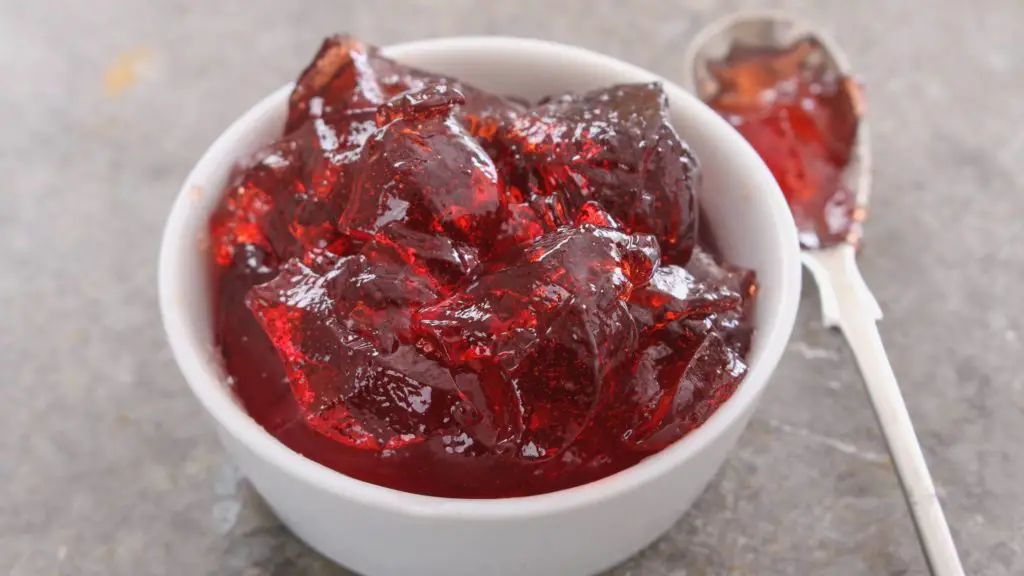
But with jelly and Jel-O, these sweet treats aren’t just unnecessary in their diet, they can be dangerous and sometimes fatal for Fido. Here’s why you should give them a wide berth…
Can Dogs Eat Jelly?
Not really. Fruit is a healthy and nourishing snack for both us and dogs. Whilst there are some fruits dogs absolutely must not have (particularly grapes, raisins and cherries), generally they can eat most types in moderation. Fruit has fructose in, a natural sugar, which dogs can have in small doses every now and then.
In jelly, however, there’s not only fructose from the fruit, but also glucose from the sugar. Usually jelly is made with quite a high sugar content to give it the moreish taste that we humans love. Dogs, though? Double no.
Not only will the glucose send them beyond the hyper stage (zoomies in all the room-ies), it can also lead to diabetes. Dogs are already more prone to diabetes naturally. The high sugar content in jelly can cause a spike in insulin which they will find harder to process because of their smaller bodies. So, if in doubt, avoid.
Jelly also uses a setting agent called pectin, which is a fiber. This causes constipation in dogs as it soaks up excess water in their digestive system. It can be used to treat diarrhea too – good – but if dogs eat too much pectin they could have serious digestive issues – bad.
What about sugar-free jelly? Can dogs eat that?
Definite no. Whilst sugar-free sounds healthier for humans, manufacturers need to keep it tasty. So they substitute sugar with xylitol, an artificial sweetener. Xylitol is toxic to dogs. This means that sugar-free jelly is actually the worst kind of jelly to give your dog, as it could poison them – even in small quantities. Do not give dogs anything containing xylitol (or sugar alcohol, as it’s also known).
Can dogs eat grape jelly?
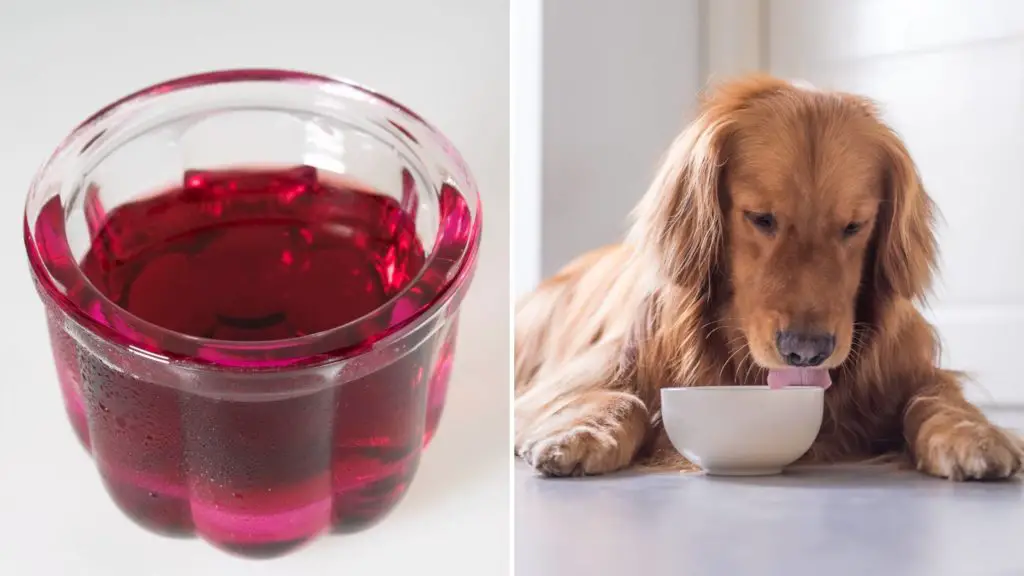
Big fat nope. If you type, ‘can dogs eat grapes’ into any search engine, it’ll tell you categorically that grapes are poisonous to dogs. They often cause kidney failure, sometimes straight away, sometimes fatally. There’s no pattern to which kinds of dogs can be affected either. Big, small, male, female, specific breed – it doesn’t matter. So grape jelly isn’t just bad for dogs because of the sugar or sweetener, it could also be lethal. Even if it doesn’t have grapes themselves, grape juice is still just as dangerous. And although the grape flavour in grape jelly might be synthetic in some brands, it’s still best to steer clear altogether. Why take the risk? Don’t let your dog eat it.
Can dogs eat raspberry jelly?
Although raspberries themselves are quite good for dogs because of the natural antioxidants, when it comes to jelly, it’s a no. The sugar content is just too darn high to be safe. Stick to the unprocessed fruit in its natural form if you want to treat your dog now and then. Fresh raspberries are high in anti-inflammatory properties, so they’re perfect for senior dogs with weary joints. Limit your dog to a few at a time though, as they do contain small amounts of naturally-occurring xylitol.
How about strawberry jelly?
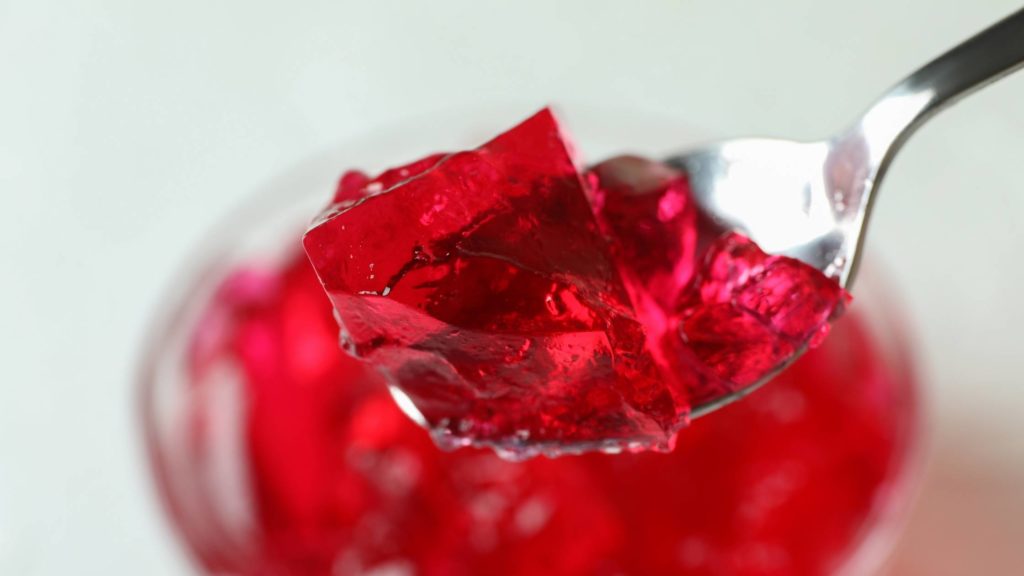
Still no. Again, dogs can eat strawberries as an occasional treat (just make sure you cut off the leaves), but in jelly it is not safe. Strawberries contain fiber, vitamin C and an enzyme that helps whiten teeth. They do also have fructose though, so only give in moderation. The fruit isn’t really the issue here, it’s the jelly. More specifically, it’s the sugar or artificial sweetener in the jelly. You can ask the question, ‘Can dogs eat jelly?’ whatever way you like. The answer is the same, whatever fruit you put in. No. It’s just not a good idea for your beloved pet.
What about peanut butter and jelly?
Everyone knows a PB and J is the best way to pick yourself up after a long day. It’s like both sides of the sandwich are giving you a hug. You sink your teeth in, chew, and feel better straight away. Then you look down and see Fido giving you the eyes. Can dogs eat peanut butter? Surely a little bite won’t hurt him?
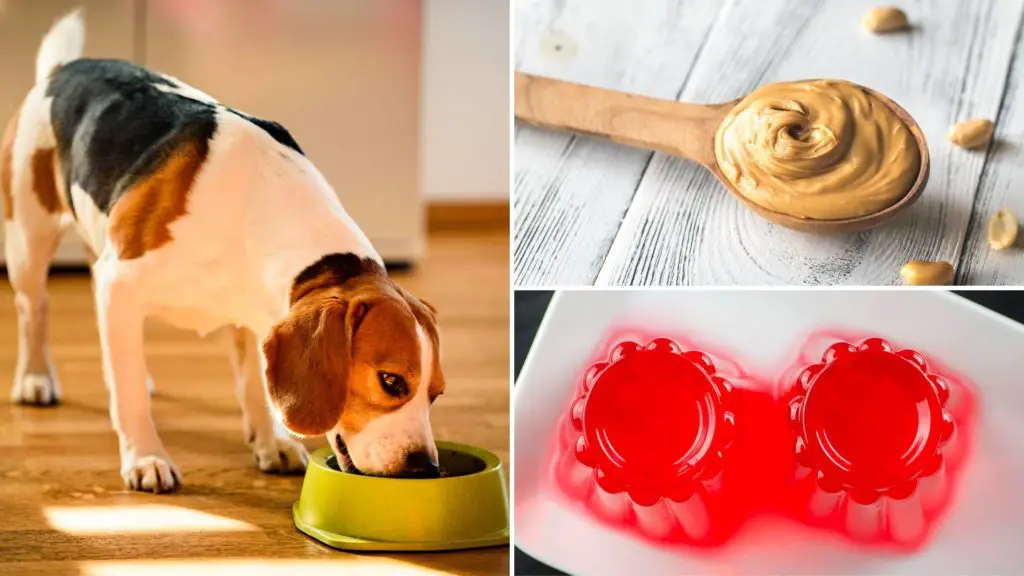
You need to check the labels really carefully. If the peanut butter has xylitol or sugar alcohol in it, then it’s an absolute no. The same goes for the jelly. If neither of them have xylitol in and you haven’t spread the jelly too thickly, it should be ok for dogs to eat a peanut butter and jelly sandwich in moderation.
Can dogs eat bread? They don’t really need it – it’s not especially bad for them, it’s just not particularly beneficial for them either. They gain nothing from eating it – except satisfaction, of course! If you really want to stop the staring, why not invest in a lick mat and just spread peanut butter straight onto that? So rather than risk the jelly (and waste bread you could be enjoying yourself!), just buy a jar of xylitol-free peanut butter and let them lick that to their heart’s content!
And can dogs eat Jello?
Jello is safe in terms of it being non-toxic, but it’s still really high in sugar and it doesn’t have any benefit for dogs. It’s best to avoid letting your dog have any to avoid a surge of insulin and its consequences. If it doesn’t lead to diabetes, it could still lead to obesity. That can put a lot of extra pressure on a dog’s joints and organs, which can then cause other health implications further down the line. You don’t want your dog in any discomfort or distress. So stick to non-sugary treats.
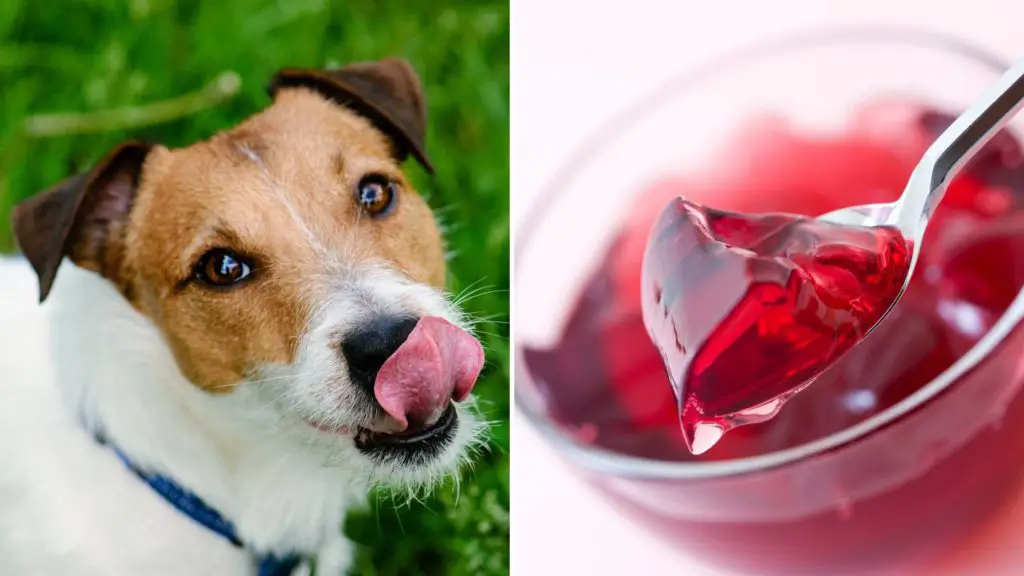
Jello contains gelatin, which is good for dogs in some contexts, just not in this instance (because of the sugar). So what’s the best gelatin for dogs? It must be a plain, unflavored variety. Used properly, you can boost your dog’s amino acids – this will be beneficial to their skin, fur and joints. Gelatin can prevent arthritis and keep their brain healthy. It can also help them gain a little weight and improve their appetite. Just make sure it doesn’t have sugar or sweetener in it.
Can dogs eat jelly beans?
Jelly beans, jelly babies, jelly tots – all of these are off the menu at the canine café. They are either ridiculously high in sugar, chemicals and colorings, or have harmful substitutes. Sugar-free sweet treats? Hello xylitol. Sometimes it’s listed as ‘sugar alcohol’, so check the ingredients carefully.
A final kicker: jelly beans and similar candy often contain caffeine. This will not only increase your hound’s heart rate, it can also damage their internal organs such as their brain, liver and kidneys.They could have seizures, hyperthermia (where their body temperature will increase), hypertension (high blood pressure), tremors and even a collapse.
Avoid, avoid, avoid. You’re either going to end up with a poorly pet or a trip to the vet. No fun for your dog, you or your wallet.
My dog ate grape jelly…
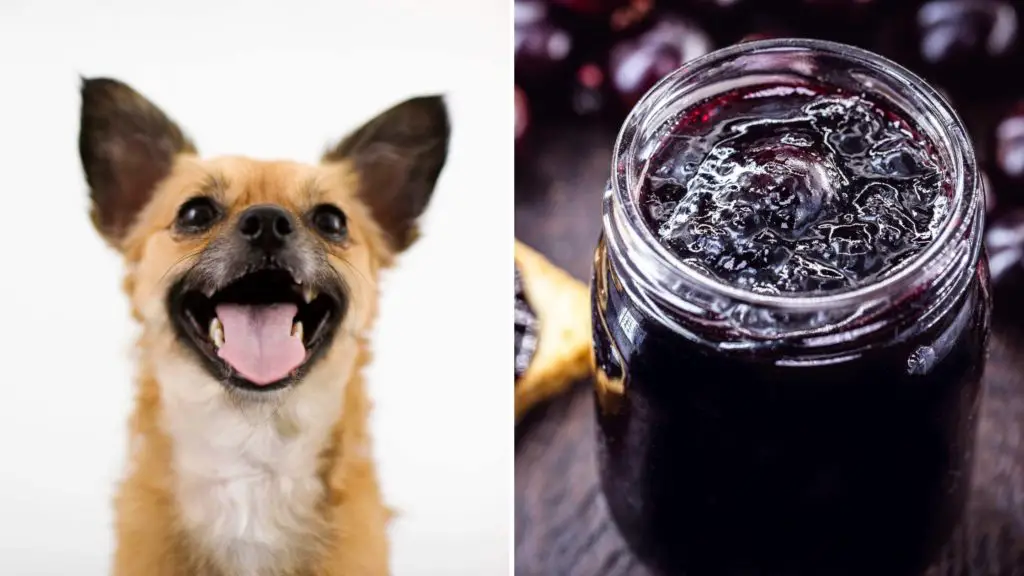
Can dogs eat jelly? Technically, yes – they can and they will! Sometimes, with all the best will in the world, you can’t protect your dog from everything. Those pesky pooches are going to get into things they shouldn’t on occasion. Lord love ‘em. If it’s regular jelly (with sugar not sweetener) it should be ok, but keep an eye on them, just in case. Ring your vet if you’re worried or want some reassurance. If the jelly or jello contains xylitol, sugar alcohol or caffeine, you should take your dog in.
However, if you catch your dog eating grape jelly try and stop them as quickly as possible and fish whatever you can out of their mouth.
You’ll need to monitor them really carefully to check for any signs of distress or difficulty. Keep an eye out for:
- Vomiting
- Loss of appetite
- Diarrhea
- Upset stomach
- Body pains
If there are any of these symptoms, contact your veterinarian right away. They will tell you what to do depending on your situation. If the symptoms are severe, don’t wait – take your dog in. Better to be safe than sorry.
If your dog seems alright after a few days of monitoring, they should be fine and you can stop worrying. Just give them an extra big hug for scaring you.
Just make sure you’ve moved the jar out of reach going forward, as a near-miss this time might be worse in the future. It needs to be away from the dog, and away from any children who don’t know better. Speaking of which, make sure you have a talk with your child and gently explain why they mustn’t feed your dog any of the above. Education is key.
So, can dogs eat jelly?
Although some types are less harmful than others, ultimately, all kinds of sugary treats are a bad idea for our canine companions. If you don’t want to be label-checking or vet-ringing, the best and easiest thing to do is to avoid giving all kinds of jelly, jello, and jelly-type candies completely.
Stick to carrots, celery, cucumber and apples (minus the pips and core) for healthy treats you can give time and time again. They’re full of vitamins and fiber, they’re low in fat and calories, and they have numerous health benefits – such as boosting energy levels, keeping the heart healthy, and preventing cancer. So while you’re tucking into your post-work PB and J, give your dog some celery sticks. Added bonus: fresh breath.
And as for Fido? He’ll still stare at you, salivating, searching your soul and summoning scraps. But let him stare. He’ll be safer that way.
To find out more about what your dog and other pets can and can’t eat, why not read some of these other articles?
References:
- ASPA, ‘People Foods to Avoid Feeding Your Pets’, https://www.aspca.org/pet-care/animal-poison-control/people-foods-avoid-feeding-your-pets, Accessed – 7 May 2021
Wikipedia, ‘Grape and raisin toxicity in dogs’, https://en.wikipedia.org/wiki/Grape_and_raisin_toxicity_in_dogs, Accessed – 7 May 2021

